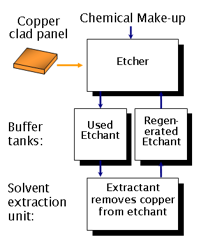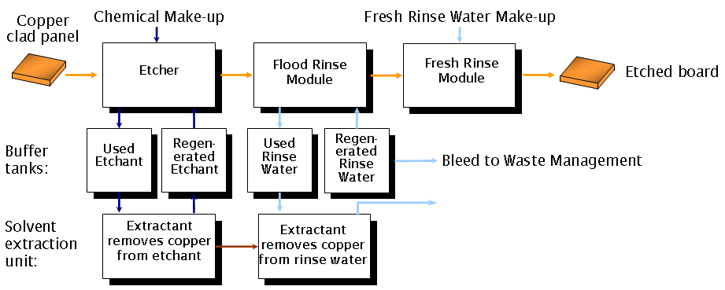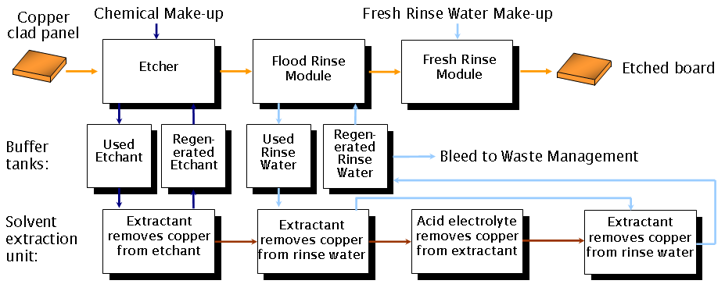Alkaline Mecer process
The First stage
As the etcher density rises and it calls for fresh material, regenerated etchant containing approximately 100 G/L copper is added to the etcher module. Spent material is removed from the module and stored in a buffer tank for processing in the Mecer system. Also added as needed is ammonia for pH control, chlorides to compensate for drag-out and etchant additive to control banking and etch speed.
When enough spent etchant has accumulated in the spent buffer tank, the Mecer system automatically turns on and begins to regenerate etchant. Using a process known as solvent extraction or liquid ion exchange, a portion of the copper is transferred out of the etchant into an organic extractant. The regenerated etchant is then sent back to storage for reuse in the etcher. The organic is passed on to the next step in the solvent extraction process.
The Second stage
As regenerated etchant is added to the etching module, regenerated rinse water is added to the flood rinse module. Regenerated rinse water contains approximately 7 g/l ammonium chloride, less than 1 ppm copper, and free ammonia. It is a very efficient rinse agent that doesn't attack resist and can be recycled. As the rinse water cascades through the flood rinse module it becomes spent and is sent to a buffer tank for storage before processing by the Mecer system. Spent rinse water is fed into the second extraction stage of the Mecer system where the copper is reduced from ~2 g/l to 5 ppm. The regenerated rinse water is then fed to the forth extraction step of the Mecer system.
The Third stage
After the organic has contacted the rinse water it is completely loaded with copper.
This copper needs to be removed before the organic can be sent to the forth stage of the Mecer system. This is done by contacting the organic with sulfuric acid. Under this
pH condition, the organic releases its copper to the acid before it is sent to the forth stage.
The Forth stage
Rinse water from the second extraction step of the Mecer system is sent to the forth extraction step of the Mecer system where the copper is reduced from ~5 ppm to less than 1 ppm. It is then sent back to a buffer tank for storage and reuse by the etching machine. A small portion of this material is also bled off to waste treatment to compensate for the volume of water being added to the process through the fresh rinse module. Typically DI water is added to this module at a rate of 50 L/H, therefore reducing rinse water consumption for a typical etcher by 90%.
Electrowinning unit
The copper loaded acid (electrolyte) travels from the third extraction stage to the electrowinning cell where the copper is plated onto copper starter sheets. When a cathode's weight reaches ~125 kg it is removed from the system and sold as electrolytic grade copper.
The process of plating the copper regenerates the acid in the electrolyte so that it is ready to be used again to strip the copper from the organic.





